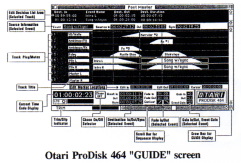Aside from the new software (which will be shipped to current owners this month), Otari has also introduced a new Hardware Control Panel (or HCP) which was demonstrated at NAB last spring. Not unlike the software, this HCP has undergone some changes, adding new features suggested by users of the prototype. The new controller is expected to be ready for shipping by the first quarter of next year. The control panel is specifically designed to eliminate having to use the keyboard and mouse of the Macintosh, bringing many of the keyboard and mouse functions to dedicated transport and edit controls on the panel. For radio, this is almost a must. In radio production studios, the more people that can operate the room and the shorter the learning curve, the better.
To further drive home how busy the Otari team has been, the long awaited DSP card for the 464 is now ready and is being shipped. The DSP card goes hand in hand with the new GUIDE software and adds many new functions to the 464 not previously available. More on GUIDE in a moment, but let's take a closer look at what the ProDisk 464 physically consists of.
As mentioned, the ProDisk is an expandable system. The smallest system is a 4-in/4-out configuration. The system used for this Test Drive is a 4-in/8-out setup. The 64-track version is a 32-in/64-out configuration. These are analog ins and outs. A 2-in/2-out digital I/O card is available for $2,075. A basic 8-track system would consist of the ProDisk Storage Unit which contains two hard drives and an 8-millimeter tape backup drive. The Audio Unit contains the processing hardware of the 464. The cost at this point is $47,150. You need a Macintosh. Otari sells a basic system with 19-inch color monitor and internal hard drive for around $6,000. The new DSP card for the ProDisk goes for $3,195 and is essentially a must, especially with the new GUIDE software. So, for a little over $56,000 you have one heck of a digital 8-track setup. Add two grand for the digital I/O if you want to mix digitally to DAT or maybe retrieve audio digitally from DAT or CD, such as sound effects or music.
The Storage Unit and Audio Unit are rack-mountable, and, aside from the tape backup drive, there's no need to access these two pieces. So, they can be installed even in another room. The Macintosh computer can be stashed under a console, leaving just the keyboard, mouse, and 19-inch monitor as components that need close proximity to the work area. It's important to note that while many hard disk based systems utilize the computer and its hard drive for actual recording and processing of the audio, this is not the case with the 464. The Mac is connected to the Storage and Audio Units with one cable and basically does nothing more than download instructions to the main system and provide the graphic display on the monitor.
 GUIDE stands for Graphical User Interface for Digital Editing. The GUIDE software replaces the old software but keeps much of the original structure of old software, so anyone currently using the old software won't be dealing with something completely foreign when they get the GUIDE software. Having only looked at the manual for the "old" ProDisk software, it's difficult to make comparisons, but it's obvious the new GUIDE software is a step towards shortening the learning curve and quickening the process of recording and editing on the 464. This review won't attempt to compare the old with the new but instead will provide an overview of the 464 as it functions under the new GUIDE software.
GUIDE stands for Graphical User Interface for Digital Editing. The GUIDE software replaces the old software but keeps much of the original structure of old software, so anyone currently using the old software won't be dealing with something completely foreign when they get the GUIDE software. Having only looked at the manual for the "old" ProDisk software, it's difficult to make comparisons, but it's obvious the new GUIDE software is a step towards shortening the learning curve and quickening the process of recording and editing on the 464. This review won't attempt to compare the old with the new but instead will provide an overview of the 464 as it functions under the new GUIDE software.
If you're familiar with the MacIntosh or the IBM Windows user interface, then you're familiar with the "click" and "drag" functions of the mouse as well as the multiple window interface that lets you have several windows "open" at the same time. If you're familiar with computer based MIDI sequencer programs, you'll also find the layout of the 464's software familiar in many ways. There are several "windows" or screens that make up the entire 464 program. All the windows you'll need for basic recording and editing can be displayed simultaneously on the 19-inch monitor.

